Foundations: Ground breaking
01 October 2018
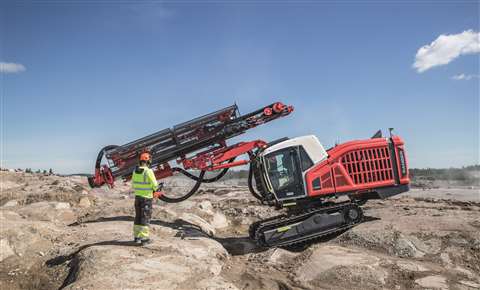
The machines and techniques used in foundation works for projects across Europe are being pushed to the limit, with the desire for greater scale, precision and efficiency driving the demand for new technology, including digital solutions.
Sandvik has been pushing the boundaries with its new Ranger DXi series top hammer drill rigs, which have several new features intended to improve the drilling process. The machines’ new rock drills have a counterweight revolving superstructure to maintain weight opposite the boom for enhanced stability and they can swivel 290° to cover an area of 55m2. This was said to save working time and minimise the need to reposition the rig. When the rigs do need moving though, this was said to have been made easy by the low centre of gravity and high tramming power.
Aside from the 290° revolving upper structure and 21 to 27kW rockdrill family, other new features of the Ranger DXi series include the iTorque control system for dealing with difficult rock, and the GT 60 tools that were said to make it possible to create straighter 92 to 127mm holes.
Operator comfort was also an important concern in the design of the new series, with the development of the new iCab cabin, which was said to have lower in-cabin noise levels and better operator ergonomics.
Customer trials
The development of the new user interface was based on input from several customer trials.
The cabin has new joysticks and control panels, and there is now space behind the operator seat for a trainer. In addition, working in partnership with the Finnish Technical Research Centre VTT, Sandvik said it had lowered the noise emissions to the lowest level for this type of drill rig.
Also using new technology to deliver higher quality, Pile Dynamics has introduced its Shaft Area Profile Evaluator (SHAPE).
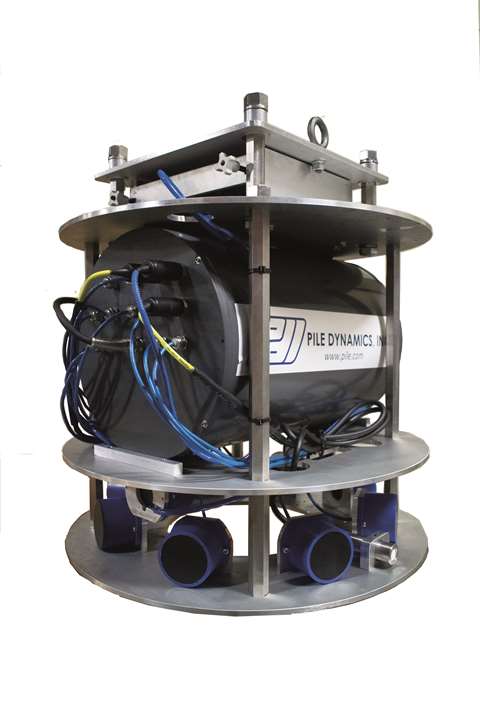
Since shafts are rarely ideal cylinders, and irregularities in the shaft foundation can affect capacity and design, according to Pile Dynamics, the company has developed the SHAPE to help control the quality of a shaft with respect to its radius, volume and verticality by better measuring its 3D profile – as well as the profile of other excavated deep foundation elements.
George Piscsalko, the company’s president, said, “We felt the market needed a modern and rugged device where we eliminate common points of failure such as electronic cables running from the surface to the device to provide increased accuracy and performance.”
Pile Dynamics said the solution was a cost-effective quality assurance testing device that could be used for deep foundations such as drilled shafts, bored piles, slurry walls and barrettes prior to filling with concrete.
The SHAPE’s drilling stem advancement rate is approximately 0.3m/s, and it offers 360˚ 2D and 3D profile views. Also, as a wireless device, it requires no electrical cabling to be run from the surface to the device during operation, increasing the system’s overall reliability, according to Pile Dynamics.
The equipment automatically corrects for changes in wave speed with depth by measuring the wave speed at each measurement location along the length of the excavation and adjusting the radius calculation based on the measured wave speed at any depth location. The SHAPE samples all sensors simultaneously at high speed, allowing it to be deployed quickly so that construction can continue at a fast rate.
In addition, the SHAPE can be operated on site or remotely with Pile Dynamics’ SiteLink technology.
Greater accuracy
The drive for greater accuracy has also prompted Liebherr to introduce its Lipos positioning system, which can be integrated into existing Liebherr IT solutions and was said to be compatible with a wide range of the company’s deep foundation machines.
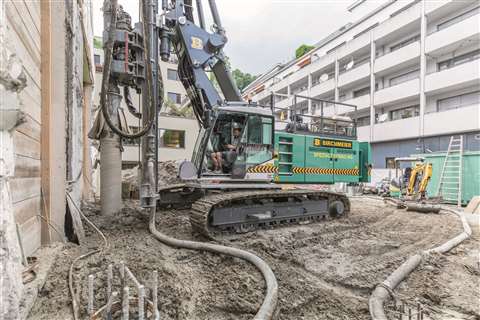
The new LRB 16 piling and drilling rig at work
It uses state-of-the-art Differential Global Navigation Satellite Systems (DGNSS) technology to position machines exactly and help them to perform piling and drilling processes precisely.
Using a factory-mounted add-on kit, Liebherr’s positioning system allows for the direct integration of a Trimble or Leica machine control system into its process data recording and reporting systems.
The kit includes a fixture so that hardware can be installed quickly and easily without the need to change the machine’s structure. The GNSS antennae are mounted on the leader for optimum signal quality and intensity.
The DGNSS data are then integrated using a software enhancement of the process data recording system (PDE). It was said that the integration of an external machine control system allowed for a comprehensive and consistent recording of positioning data in PDE as well as visualisation and analysis in the Process Data Reporting (PDR2) software.
LiDAT data transmission enables the automated transfer of recorded data out from the machine to the PDR2 software. Liebherr said the reports generated can be used for traceability, documentation and quality assurance.
By combining the visualised digitised drilling plans with the DGNSS and machine data, the operator is given guidance on how to position the machine and execute the drilling process with precision, and time-consuming surveying tasks are avoided while site safety is enhanced.
Liebherr has also recently introduced its new LRB 16 piling and drilling rig, which was said to be suitable for the diverse requirements of deep foundation works.
It gets its name from the sledge’s travel distance, which is approximately 16m. The company has put special emphasis on the machine’s compact design and low operating weight of 48 tonnes, resulting in low ground pressure. Also, the undercarriage was said to offer good stability, which can be enhanced with optional rear supports.
The LRB 16 is powered by a 390kW Liebherr diesel engine with a reduced engine speed of 1,700rpm, compared to earlier models. This, combined with new hydraulic concepts, helps keep fuel consumption low.
The parallel kinematics on the new piling and drilling rig have a large working area and enable the leader to be folded back. The rigid leader, which measures approximately 12.5m, absorbs high torque and is fitted with a rope crowd system for high pull forces of up to 200kN. Furthermore, the quick connection system was said to allow for the speedy fitting or exchange of working tools.
Special attention was paid to the improvement of operator comfort with the new cabin concept of the LRB 16. The cabin has a new air conditioning system and an orthopaedic seat with automatic adjustment, and the view from within has been optimised.
As standard, the new piling and drilling rig is fitted with control and assistance systems, and it has obstacle recognition, which enables obstacles in the soil to be sensed and avoided before damage can be done to the attachment or the machine.
One of the most frequent types of application for the LRB 16 was said to be the installation of slurry walls with the aid of Liebherr’s vibrator type LV 20.
Bus terminal
Liebherr is currently involved in a project to build a modern bus terminal with a capacity of 1,500 passengers per day on the Sholkovskoye Chaussee in the Russian capital, Moscow.
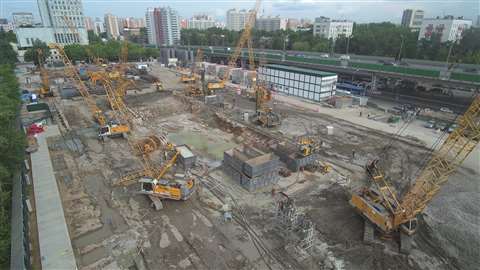
A fleet of eight Liebherr machines lay the foundations for a new bus terminal in Moscow
The contractor Fensma is relying on Liebherr equipment to install slurry walls and barrette piles for the structure. Of the €73 million that the project is expected to cost, about one fifth will be attributable to the deep foundation work.
This foundation work is being carried out by a fleet of eight Liebherr machines – seven duty cycle crawler cranes with lifting capacities of between 70 and 120 tonnes, and one LRB 255 piling and drilling rig.
Cast-in-place slurry walls with a total of 310,000m² and 3,500 tonnes of reinforcement cages are being installed as a lining wall for the foundation pit. For this, two carrier machines have been fitted with hydraulic grabs and four with mechanical grabs, which can be interchanged between the duty cycle crawler cranes.
The slurry wall has a maximum depth of 52m and is 800mm thick. It takes 18 hours for one bite with a length of 2,800mm to be excavated, and a delivery pipe is used for filling with concrete.
With regard to the 154 individual barrette piles that need inserting for the foundations, each barrette has a depth of 52m and a volume of 110m³ of concrete. A total of 800 tonnes of steel are being installed.
Fensma has been faced not only with tight time constraints – having to complete the work within a two-year period – but also by difficult soil conditions.
There was a combination of loam, sand, clay and groundwater, which has made it particularly challenging to achieve the necessary verticality of the slurry wall.
Elsewhere in Russia, Bauer was recently called upon to carry out foundation works for a project in St Petersburg.
After the company’s Russian subsidiary Bauer Technologie carried out foundation works in 2013 and 2014 for the Lakhta Tower, which stands as the tallest building in Europe at 462m, it was also called on to carry out foundation work for the neighbouring Lakhta Centre, of which the Lakhta Tower will be the core.
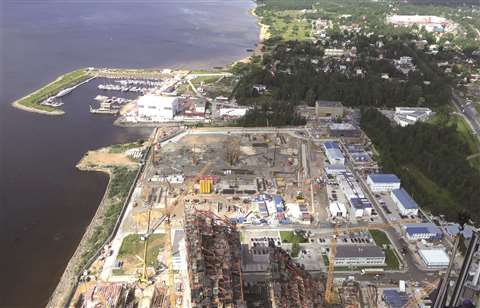
Bauer Technologie was required to perform pile drilling work and construct an excavation pit for the office complex. This required the planning and installation of 1,449 piles and 870m of diaphragm wall, along with other supplementary services.
The ground initially consisted of sandy filling materials and then moved into alluvial deposits, which included a soft layer of silt and clay that contained large granite boulders of up to 2m in diameter. This was followed by a layer of hard claystone down to a depth of 100m.
Six Bauer BG 28 to BG 40 rotary drilling rigs were used, as well as two hydraulic grabs.
New headquarters
In Wittlich, Germany, Wirtgen has been helping to prepare the ground for its Benninghoven sister company’s new headquarters, which is being built over an area of 310,000m2 at a cost of €130 million.
First on the site were the civil engineers. A key part of their task was to create level and load-bearing surfaces for the 60,000m2 production and logistics hall, the 12,000m2 central building with offices, and the traffic routes.
To that end, the terrain was completely remodelled and stabilised.
Heinrich Plein, production engineer at Benninghoven and member of the internal construction site management team, said, “The height difference was originally around 8 to 9m. Levelling the area required removing and replacing some 400,000m3 of soil.”
Two Wirtgen soil stabilisers and six Hamm compactors were used for the project.
The team from EBS Bodenstabilisierungs used the soil stabilisers to mix in a lime-cement mixture tailored to the soil quality in up to 12 layers, each 40cm deep.
Once the binder had been mixed in, contractor Strabag had Hamm compactors waiting in the wings for the compaction work. The first passes were completed by multiple compactors with padfoot drums working in pairs or trios. Two further compactors with smooth drums then carried out the final compaction work.
Eduard Weber, building material inspector with SBT, the road and concrete construction lab charged with quality assurance, said, “All the load-bearing capacity and compaction values measured met the requirements of the construction contract.
The individual layers are even, smooth and have no cracks – a textbook example.”
Wirtgen recently launched the new Duraforce milling and mixing rotor for use in both soil stabilisation and cold recycling.
The company said the optimal interplay of the rotor, the holder base, the quick-change toolholder system and the point-attack tools is essential for the milling and mixing capacity to remain high in the long term.
The point-attack tools of generation Z were said to have a high wear and impact resistance, and high-grade tool alloys give maximum strength to the holder base.
By using high-grade materials and intelligent component geometry, Wirtgen aims to ensure that the rotor has a long service life even in tough applications, such as stabilising soil that contains larger stones.
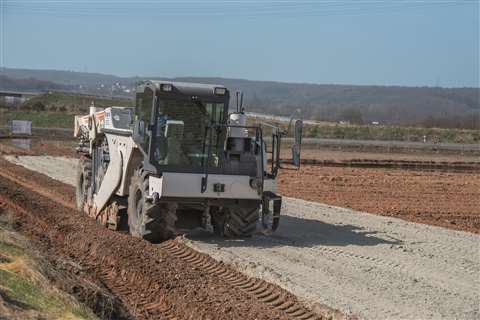
The hard-wearing quick-change toolholder systems on the corner ring segments of the Duraforce milling and mixing rotor were also said to be easy to access, making for quick changes of the segments, should the need arise.
The tool spacing and the arrangement of the cutting tools on the milling and mixing rotor are tailored to the individual machine capacity, which means that a high-quality mix is produced in a smooth, quiet milling and mixing process, according to Wirtgen.
The geometry of the holder base and the large diameter of the Duraforce rotor combine to produce a mixing chamber whose size varies according to the milling depth, ensuring that materials are mixed homogeneously, it said.
Urban infrastructure
Looking to the future of foundations, Arno Halbeisen, a product manager at Liebherr, recently spoke at the DFI Conference: Innovative Technologies and Digital Solutions in Focus, at which the challenges of upcoming urban infrastructure megaprojects were explored, along with the technologies and techniques to overcome these challenges.
His talk was entitled Deep Foundation Jobsites of the Future: digitisation and networking as major strategic factors for information management systems.
It was said that as key elements in the digital transition, digitalisation and connectivity have the scope to provide both support and direction throughout the lifespan of a deep foundation jobsite.
Information management systems, planning programs and BIM methodology were described by Halbeisen as comprehensive, multilevel, interdisciplinary tools that assist in the decision-making and planning of jobsites, and he said they are characteristic of the changing environment.
Digital assistance programs enable the optimisation of resource use and they significantly contribute to the realisation of a smooth ground preparation process, according to Halbeisen.
Innovative digitalisation solutions can already be deployed as standard for a large variety of deep foundation projects regardless of their complexity or dimension.
How far it is taken depends on how data is used and what it contributes to the success of geotechnical construction projects.




